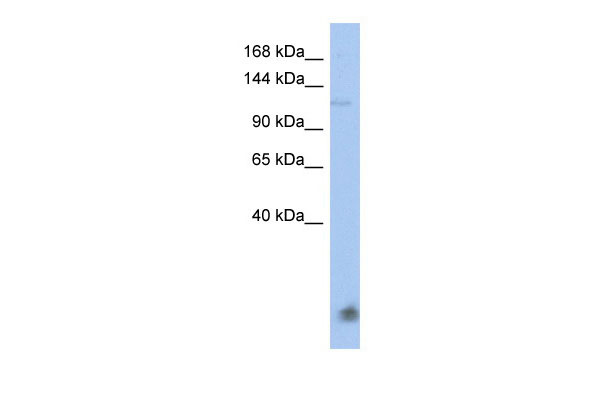HERC5 antibody - N-terminal region
Rabbit Polyclonal Antibody
- 产品详情
- 实验流程
Application
| WB |
|---|---|
| Primary Accession | Q9UII4 |
| Other Accession | NM_016323, NP_057407 |
| Reactivity | Human, Dog, Bovine |
| Predicted | Human, Dog, Bovine |
| Host | Rabbit |
| Clonality | Polyclonal |
| Calculated MW | 116852 Da |
| Gene ID | 51191 |
|---|---|
| Alias Symbol | CEB1, CEBP1 |
| Other Names | E3 ISG15--protein ligase HERC5, 6.3.2.-, Cyclin-E-binding protein 1, HECT domain and RCC1-like domain-containing protein 5, HERC5, CEB1, CEBP1 |
| Format | Liquid. Purified antibody supplied in 1x PBS buffer with 0.09% (w/v) sodium azide and 2% sucrose. |
| Reconstitution & Storage | Add 50 ul of distilled water. Final anti-HERC5 antibody concentration is 1 mg/ml in PBS buffer with 2% sucrose. For longer periods of storage, store at 20°C. Avoid repeat freeze-thaw cycles. |
| Precautions | HERC5 antibody - N-terminal region is for research use only and not for use in diagnostic or therapeutic procedures. |
| Name | HERC5 |
|---|---|
| Synonyms | CEB1, CEBP1 |
| Function | Major E3 ligase for ISG15 conjugation (PubMed:26355087, PubMed:27534820, PubMed:27564865, PubMed:34572049, PubMed:37279284). Acts as a positive regulator of innate antiviral response in cells induced by interferon. Functions as part of the ISGylation machinery that recognizes target proteins in a broad and relatively non-specific manner. Catalyzes ISGylation of IRF3 which results in sustained activation, it attenuates IRF3-PIN1 interaction, which antagonizes IRF3 ubiquitination and degradation, and boosts the antiviral response. Mediates ISGylation of the phosphatase PTEN leading to its degradation, thus alleviating its suppression of the PI3K-AKT signaling pathway and promoting the production of cytokines that facilitate bacterial clearance (PubMed:37279284). Interferes with the function of key viral structural proteins such as ebolavirus structural protein VP40 or HIV-1 protein GAG (PubMed:22093708, PubMed:34572049). Catalyzes ISGylation of influenza A viral NS1 which attenuates virulence; ISGylated NS1 fails to form homodimers and thus to interact with its RNA targets. Catalyzes ISGylation of papillomavirus type 16 L1 protein which results in dominant-negative effect on virus infectivity. Physically associated with polyribosomes, broadly modifies newly synthesized proteins in a cotranslational manner. In an interferon-stimulated cell, newly translated viral proteins are primary targets of ISG15. Promotes parkin/PRKN ubiquitin E3 ligase activity by suppressing the intramolecular interaction that maintains its autoinhibited conformation (PubMed:27534820). |
| Cellular Location | Cytoplasm, perinuclear region. Cytoplasm Note=Associated with the polyribosomes, probably via the 60S subunit |
| Tissue Location | Expressed in testis and to a lesser degree in brain, ovary and placenta. Found in most tissues at low levels |
Research Areas
For Research Use Only. Not For Use In Diagnostic Procedures.
Application Protocols
Provided below are standard protocols that you may find useful for product applications.
REFERENCES
Salon,C.,(2007)Oncogene26(48),6927-6936ReconstitutionandStorage:Forshorttermuse,storeat2-8Cupto1week.Forlongtermstorage,storeat-20Cinsmallaliquotstopreventfreeze-thawcycles.
终于等到您。ABCEPTA(百远生物)抗体产品。
点击下方“我要评价 ”按钮提交您的反馈信息,您的反馈和评价是我们最宝贵的财富之一,
我们将在1-3个工作日内处理您的反馈信息。
如有疑问,联系:0512-88856768 tech-china@abcepta.com.























 癌症的基本特征包括细胞增殖、血管生成、迁移、凋亡逃避机制和细胞永生等。找到癌症发生过程中这些通路的关键标记物和对应的抗体用于检测至关重要。
癌症的基本特征包括细胞增殖、血管生成、迁移、凋亡逃避机制和细胞永生等。找到癌症发生过程中这些通路的关键标记物和对应的抗体用于检测至关重要。 为您推荐一个泛素化位点预测神器——泛素化分析工具,可以为您的蛋白的泛素化位点作出预测和评分。
为您推荐一个泛素化位点预测神器——泛素化分析工具,可以为您的蛋白的泛素化位点作出预测和评分。 细胞自噬受体图形绘图工具为你的蛋白的细胞受体结合位点作出预测和评分,识别结合到自噬通路中的蛋白是非常重要的,便于让我们理解自噬在正常生理、病理过程中的作用,如发育、细胞分化、神经退化性疾病、压力条件下、感染和癌症。
细胞自噬受体图形绘图工具为你的蛋白的细胞受体结合位点作出预测和评分,识别结合到自噬通路中的蛋白是非常重要的,便于让我们理解自噬在正常生理、病理过程中的作用,如发育、细胞分化、神经退化性疾病、压力条件下、感染和癌症。






